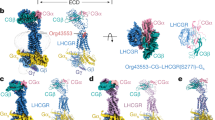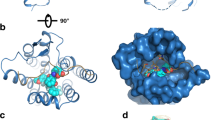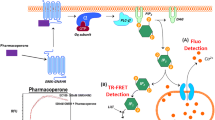Abstract
SPECIFIC receptors for lutropin1,2 (luteinizing hormone; LH) and follitropin3,4 (follicle-stimulating hormone; FSH) mediate the actions of human chorionic gonadotropin (hCG) and FSH5 on the gonads. Here we report that short independent sequences of the β-subunit enable hCG to distinguish between the receptors for FSH and LH. Residues between the 11lth and 12th cysteines restrict FSH receptor binding; residues between the 10th and 11th cysteines and, to a much lesser extent, residues carboxy-terminal to the 11th cysteine also affect LH receptor binding. CF101–109, an hCG analogue containing hFSHβ residues between the 11th and 12th cysteines, had high affinity for both LH and FSH receptors. Modifications to CF101-109 that reduce binding to either LH or FSH receptors yield gonadotropin analogues having differing ratios of LH:FSH activity. Ligand-binding specificity of the LH receptor is determined by residues encoded by parts of exons 2–4 and 7–9 which prevent hFSH binding but have little effect on hCG binding. FSH receptor specificity is controlled primarily by residues encoded by exons 5 and 6 that prevent hCG binding but have little effect on hFSH binding. These determinants can be interchanged to create receptor analogues that bind hCG and hFSH. Our observations support a model in which distinct negative determinants restrict ligand-receptor interaction. This explains co-evolution of binding specificity in families of homologous ligands and their receptors. Natural or designed manipulation of these determinants leads to the 'evolution' of new, specific protein-protein interactions.
This is a preview of subscription content, access via your institution
Access options
Subscribe to this journal
Receive 51 print issues and online access
$199.00 per year
only $3.90 per issue
Buy this article
- Purchase on Springer Link
- Instant access to full article PDF
Prices may be subject to local taxes which are calculated during checkout
Similar content being viewed by others
References
Segaloff, D. L., Sprengel, R., Nikolics, G. & Ascoli, M. Rec. Prog. Horm. Res. 46, 261–301 (1990).
Koo, Y. B., Ji, I., Slaughter, R. G. & Ji, T. H. Endocrinology 128, 2297–2308 (1991).
Sprengel, R., Braun, T., Nikolics, K., Segaloff, D. L. & Seeburg, P. H. Molec. Endocr. 4, 525–530 (1990).
Heckert, L. L., Daley, I. J. & Griswold, M. D. Molec. Endocr. 6, 70–80 (1992).
Pierce, J. G. & Parsons, T. F. A. Rev. Biochem. 50, 465–495 (1981).
Murphy, B. D. & Martinuk, S. D. Endocr. Rev. 12, 27–44 (1991).
Braun, T., Schofield, P. R. & Sprengel, R. EMBO J. 10, 1885–1890 (1991).
Moyle, W. R., Bernard, M. P., Myers, R. V., Marko, O. M. & Strader, C. D. J. biol. Chem. 266, 10807–10812 (1991).
Nagayama, Y. et al. Proc. natn. Acad. Sci. U.S.A. 88, 902–905 (1991).
Licht, P. et al. Rec. Prog. Horm. Res. 33, 169–248 (1977).
Noce, T. et al. J. molec. Endocr. 3, 129–137 (1989).
Fiddes, J. C. & Talmadge, K. Rec. Prog. Horm. Res. 40, 43–78 (1984).
Lee, J. et al. J. biol. Chem. 267, 16283–16287 (1992).
Vilcek, J. & Lee, R. H. J. biol. Chem. 266, 7313–7316 (1991).
Bewley, T. A. & Li, C. H. Adv. Enzym. 42, 73 (1975).
VanOstade, X. et al. Nature 361, 206–207 (1993).
Campbell, R. K., Dean Emig, D. M. & Moyle, W. R. Proc. natn. Acad. Sci. U.S.A. 88, 760–764 (1991).
Moyle, W. R., Ehrlich, P. H. & Canfield, R. E. Proc. natn. Acad. Sci. U.S.A. 79, 2245–2249 (1982).
Bernard, M. P., Myers, R. V. & Moyle, W. R. Molec. cell. Endocr. 71, R19–R23 (1990).
Brooker, J., Harper, J. F., Terasaki, W. L. & Moylan, R. D. Adv. Cyclic Nucleotide Res. 10, 1–33 (1992).
Munson, P. J. & Rodbard, D. Analyt. Biochem. 107, 220–239 (1980).
Xie, Y.-B., Wang, H. & Segaloff, D. L. J. biol. Chem. 265, 21411–21414 (1990).
Moyle, W. R. et al. J. biol. Chem. 265, 8511–8518 (1990).
Ho, S. N., Hunt, H. D., Horton, R. M., Pullen, J. K. & Pease, L. R. Gene 77, 51–59 (1989).
Author information
Authors and Affiliations
Rights and permissions
About this article
Cite this article
Moyle, W., Campbell, R., Myers, R. et al. Co-evolution of ligand-receptor pairs. Nature 368, 251–255 (1994). https://doi.org/10.1038/368251a0
Received:
Accepted:
Issue Date:
DOI: https://doi.org/10.1038/368251a0
This article is cited by
-
Extensive conservation of the proneuropeptide and peptide prohormone complement in mollusks
Scientific Reports (2019)
-
Molecular evolution of ACTIN RELATED PROTEIN 6, a component of SWR1 complex in Arabidopsis
Journal of Plant Biology (2016)
-
Target-Driven Evolution of Scorpion Toxins
Scientific Reports (2015)
-
Molecular cloning, characterization, and expression analysis of luteinizing hormone receptor gene in turbot (Scophthalmus maximus)
Fish Physiology and Biochemistry (2014)
-
The neuropeptide NLP-22 regulates a sleep-like state in Caenorhabditis elegans
Nature Communications (2013)
Comments
By submitting a comment you agree to abide by our Terms and Community Guidelines. If you find something abusive or that does not comply with our terms or guidelines please flag it as inappropriate.



